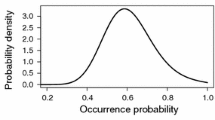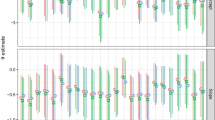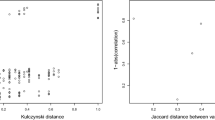Abstract
Akaike’s information criterion (AIC) is increasingly being used in analyses in the field of ecology. This measure allows one to compare and rank multiple competing models and to estimate which of them best approximates the “true” process underlying the biological phenomenon under study. Behavioural ecologists have been slow to adopt this statistical tool, perhaps because of unfounded fears regarding the complexity of the technique. Here, we provide, using recent examples from the behavioural ecology literature, a simple introductory guide to AIC: what it is, how and when to apply it and what it achieves. We discuss multimodel inference using AIC—a procedure which should be used where no one model is strongly supported. Finally, we highlight a few of the pitfalls and problems that can be encountered by novice practitioners.
Similar content being viewed by others
References
Ackerman JT, Eadie JM (2003) Current versus future reproduction: an experimental test of parental decisions using nest desertion by mallards (Anas platyrhynchos). Behav Ecol Sociobiol 54:264–273
Akaike H (1973) Information theory as an extension of the maximum likelihood principle. In: Petrov BN, Csaki F (eds) Second international symposium on information theory. Budapest, Akaemiai Kiado, pp 267–281
Bolker BM (2008) Ecological models and data in R. Princeton University Press, Princeton
Buckland ST, Burnham KP, Augustin NH (1997) Model selection: an integral part of inference. Biometrics 53:603–618
Burnham KP, Anderson DR (2001) Kullback-Leibler information as a basis for strong inference in ecological studies. Wildlife Res 28:111–119
Burnham KP, Anderson DR (2002) Model selection and multimodel inference, 2nd edn. Springer, New York
Burnham KP, Anderson DR (2004) Multimodel inference: understanding AIC and BIC in model selection. Sociol Methods Res 33:261–304
Burnham KP, Anderson DR, Huyvaert KP (2010) AICc model selection in the ecological and behavioral sciences: some background, observations and comparisons. Behav Ecol Sociobiol. doi:10.1007/s00265-010-1029-6
Cardoso GC, Atwell JW, Ketterson ED, Price TD (2007) Inferring performance in the songs of dark-eyed juncos (Junco hyemalis). Behav Ecol 18:1051–1057
Dochtermann NA, Jenkins SH (2010) Developing multiple hypotheses in behavioral ecology. Behav Ecol Sociobiol. doi:10.1007/s00265-010-1039-4
Garamszegi LZ (2010) Information-theoretic approaches to statistical analysis in behavioural ecology: an introduction. Behav Ecol Sociobiol. doi:10.1007/s00265-010-1028-7
Garamszegi LZ, Calhim S, Dochtermann N, Hegyi G, Hurd PL, Jørgensen C, Katsukake N, Lajeunesse MJ, Pollard KA, Schielzeth H, Symonds MRE, Nakagawa S (2009) Changing philosophies and tools for statistical inferences in behavioral ecology. Behav Ecol 20:1363–1375
Guthery FS, Brennan LA, Peterson MJ, Lusk JJ (2005) Information theory in wildlife science: critique and viewpoint. J Wildl Manag 69:457–465
Hawkins BA, Diniz-Filho JAF, Soeller SA (2005) Water links the historical and contemporary components of the Australian bird diversity gradient. J Biogeog 32:1035–1042
Hegyi G, Garamszegi LZ (2010) Using information theory as a substitute for stepwise regression in ecology and behavior. Behav Ecol Sociobiol. doi:10.1007/s00265-010-1036-7
Hilborn R, Mangel M (1997) The ecological detective: confronting models with data. Princeton University Press, Princeton
Johnson JB, Omland KS (2004) Model selection in ecology and evolution. Trends Ecol Evol 19:101–108
Kass RE, Raftery AE (1995) Bayes factors. J Am Stat Assoc 90:773–795
Lau B, Glimcher PW (2005) Dynamic response-by-response models of matching behavior in rhesus monkeys. J Exp Anal Behav 84:555–579
Link WA, Barker RJ (2006) Model weights and the foundations of multimodel inference. Ecology 87:2626–2635
Lukacs PM, Burnham KP, Anderson DR (2009) Model selection bias and Freedman’s paradox. Ann Inst Stat Math 62:117–125
Luttbeg B, Hammond JI, Sih A (2009) Dragonfly larvae and tadpole frog space use games in varied light conditions. Behav Ecol 20:13–21
Mazerolle MJ (2006) Improving data analysis in herpetology: using Akaike’s Information Criterion (AIC) to assess the strength of biological hypotheses. Amphibia-Reptilia 27:169–180
Møller AP, Jennions MD (2002) How much variance can be explained by ecologists and evolutionary biologists? Oecologia 132:492–500
Mundry R (2010) Issues in information theory based statistical inference—a commentary from a frequentist’s perspective. Behav Ecol Sociobiol. doi:10.1007/s00265-010-1040-y
Nakagawa S, Freckleton RP (2008) Missing inaction: the dangers of ignoring missing data. Trends Ecol Evol 23:592–596
Nakagawa S, Freckleton RP (2010) Model averaging, missing data and multiple imputation: a case study for behavioural ecology. Behav Ecol Sociobiol. doi:10.1007/s00265-010-1044-7
Richards SA (2005) Testing ecological theory using the information-theoretic approach: examples and cautionary results. Ecology 86:2805–2814
Richards SA (2008) Dealing with overdispersed count data in applied ecology. J Appl Ecol 45:218–227
Richards SA, Whittingham MJ, Stephens PA (2010) Model selection and model averaging in behavioural ecology: the utility of the IT-AIC framework. Behav Ecol Sociobiol. doi:10.1007/s00265-010-1035-8
Stephens PA, Buskirk SW, Hayward GD, Martínez del Rio C (2005) Information theory and hypothesis testing: a call for pluralism. J Appl Ecol 42:4–12
Stephens PA, Buskirk SW, Martínez del Rio C (2007) Inference in ecology and evolution. Trends Ecol Evol 22:192–197
Symonds MRE, Johnson CN (2008) Species richness and evenness in Australian birds. Am Nat 171:480–490
Thorup K, Alerstam T, Hake M, Kjellén N (2006) Traveling or stopping of migrating birds in relation to wind: an illustration for the osprey. Behav Ecol 17:497–502
Towner MC, Luttbeg B (2007) Alternative statistical approaches to the use of data as evidence for hypotheses in human behavioral ecology. Evol Anthropol 16:107–118
Whittingham MJ, Stephens PA, Bradbury RB, Freckleton RP (2006) Why do we still use stepwise modeling in ecology and behaviour? J Anim Ecol 75:1182–1189
Acknowledgments
This paper originates from a presentation by the first author at the 12th International Behavioral Ecology Congress at Cornell University in the post-conference symposium ‘Advances in statistical philosophy and experimental design in behavioral ecology’ organised by László Garamszegi and Shinichi Nakagawa. We thank László Garamszegi for inviting us to contribute to this issue. We are indebted to Gonçalo Cardoso for allowing us to use and reanalyse his junco data for the example in this paper. We thank six anonymous reviewers for their time and efforts. The members of the Animal Behaviour and Evolution group at the University of Melbourne also provided useful feedback on the manuscript. MRES was financially supported by the Australian Research Council.
Author information
Authors and Affiliations
Corresponding author
Additional information
Communicated by L. Garamszegi
This contribution is part of the Special Issue “Model selection, multimodel inference and information-theoretic approaches in behavioural ecology” (see Garamszegi 2010).
Rights and permissions
About this article
Cite this article
Symonds, M.R.E., Moussalli, A. A brief guide to model selection, multimodel inference and model averaging in behavioural ecology using Akaike’s information criterion. Behav Ecol Sociobiol 65, 13–21 (2011). https://doi.org/10.1007/s00265-010-1037-6
Received:
Revised:
Accepted:
Published:
Issue Date:
DOI: https://doi.org/10.1007/s00265-010-1037-6




